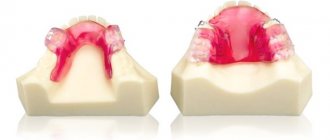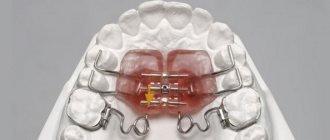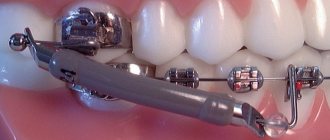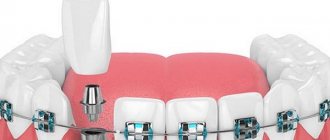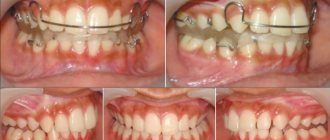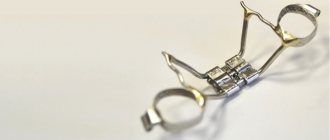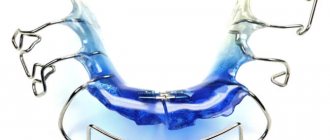3984
There are now many effective techniques for correcting orthodontic abnormalities. But, sometimes, a serious deviation in the development of the jaw arch is diagnosed, requiring special treatment. In such cases, the Brückl-Reichenbach apparatus is used, which is an effective device that brings the dentition to its normal position.
Device and principle of operation
The effect of the device is due to its special design. The classic version of the orthodontic device is a plate that accurately follows the relief of part of the palate and gums.
The plate is equipped with an inclined plane in the form of a semicircular arc, which plays the main corrective role. The arch is located in the area of the anterior group of teeth. The structure is installed using built-in clasps (loops), which are placed on the last molars.
photo: diagram of Brückl's apparatus
The operating principle of this design is based on the springy properties of the arch and the contractility of the muscles involved in chewing.
The whole correction process is as follows: while wearing it, the front teeth of the upper jaw touch the plate and are placed on it, which causes forceful pressure . Due to this effort, the lower crowns of the front row begin to gradually change their position, moving inward, and the upper ones towards the lips.
To maintain constant pressure, the dentist periodically corrects the acting arch, compressing it or stretching it.
Often, to increase the effectiveness of treatment, the dentist recommends using other orthodontic devices in conjunction with this device : a head cap, an extraoral elastic cord, a chin guard.
The listed additional elements will not only speed up the straightening process, but will also minimize the risk of the teeth returning to their previous position.
The principle of operation of the Bruckle apparatus
The therapeutic effect of the Bruckle apparatus is achieved using:
- the impact of a plate having an inclined surface on the jaw muscles, which move the lower incisors in the desired (distal) direction;
- the upper incisors, in contact with the plate, gradually move vestibularly - this is how the malocclusion is corrected;
- During treatment, as necessary, the orthodontist changes the inclination of the plate by compressing or stretching the metal arch.
Purpose
This device is designed to normalize the position of teeth, both during the period of mixed and permanent dentition. But mainly it is prescribed to correct the bite of permanent teeth.
This is due to the fact that with a mixed bite, the jaw is not yet fully formed and more gentle methods can be used to straighten it .
The main indications for prescribing a Brückle appliance are the following orthodontic deviations:
- Deep bite in the lateral part of the dentition. The use of the device allows you to separate the tight fit of the crowns of opposite jaws.
- Mesial bite (gnathic form).
- Pronounced reverse incisal overlap, more than 3 mm deep.
- Inward displacement of the front row of teeth (palatal position of the crowns).
- Abnormal enlargement of the lower jaw.
- Macrodentia.
- Abnormal bite of neutral type.
- Prognathia of the lower jaw.
The decision on the advisability of using a Bruckle device to correct the bite in these pathologies is made only by the orthodontist.
Andresen-Goipl activator
Consists of two base plates /for the upper and lower jaws/, connected along the occlusion line - a monoblock. It has a vestibular retraction arch, screws and other mechanical elements. Combined action device, removable. Used in mixed dentition to treat malocclusions in three planes. This device uncouples the bite, activates the growth of underdeveloped areas of the jaws, preventing excessive development, produces retraction of individual teeth, and dentoalveolar advancement of lateral or anterior teeth.
Contraindications
The use of this device is not possible in all cases, as there are some restrictions. One of the main contraindications is the period of baby teeth. At this stage, the use of the device is considered too aggressive a measure, which may cause disruption of the correct formation of the jaws.
In addition, the device cannot be used to treat incisal overlap, the depth of which is less than 3 ml. The distal type of bite and crowding of the anterior teeth in the lower jaw are also contraindications.
Diseases of periodontal and dental tissue are considered relative contraindications. After they are eliminated, the device can be used.
Also, a temporary obstacle to installation will be the abnormal development of the frenulum of the lips and tongue . In this case, preliminary low-traumatic surgical intervention will be required.
Advantages and disadvantages
Like any other orthodontic device, this device has its advantages and disadvantages that distinguish it from other corrective devices.
Advantages:
- Unlike other devices, here the arc is not activated, but acts as a fixing element.
- Absence of occlusal type pads in the lateral sections of the device. This allows you to more effectively influence the jaw, helping to lengthen the dental alveolar arch.
- The plate can be removed and stored in a container at any time, so you can make it unnoticeable to others.
- When treating deep bites, this design showed the fastest effect.
- After treatment, the device can be used as a retention plate. To do this, you just need to cut off the inclined plane with a regular cutter and process the resulting sharp edges.
The disadvantages of the device include the following:
- High cost compared to similar designs.
- Duration of treatment.
- The need to use auxiliary elements.
- Constant adjustment. When using the Bruckle apparatus, adjustments are made once every two weeks.
- Also, one of the disadvantages is the fact that if it breaks down, you will have to wait for a new device to be made. And at this time, the dentition remains without pressure and the risk of reducing all effort to zero increases.
What is the price?
When visiting a doctor, it is important for patients to know what price to expect to straighten a malocclusion.
The price for installing a Brückle apparatus consists of::
- the cost of the device itself,
- prices for orthodontic consultation,
- cost for possible repairs or structural corrections.
On average, a Bruckle orthodontic device costs from 4,500 to 6,000 rubles. This range depends on the plate material and metal elements used.
An orthodontist consultation ranges from 900 to 2000 rubles. Repairs, corrections, impressions and other related services will cost 800-1700 rubles.
As a result, we get a price from 6,200 to 10,000 rubles for installation, manufacturing and correction of the device.
The Brückle appliance is an effective means of straightening the mesial bite, but it will take some time to manufacture and install.
It is important to follow all the rules for caring for the structure in order to achieve maximum effect in treatment.
If you find an error, please select a piece of text and press Ctrl+Enter.
Tags bite correction plates for teeth straightening bite
Did you like the article? stay tuned
Previous article
What is mucositis of the oral mucosa?
Next article
Splat toothbrush: recommendations for selection and use
Manufacturing stages
Treatment with this device requires its individual manufacture.
Before this, the dentist conducts an examination to identify all dental problems and a detailed study of malocclusion.
Only after a complete history collection does the orthodontist begin to manufacture the device.
The whole process is divided into several stages:
- Taking an impression using a special material from the lower and upper jaws.
- Casting a working model from the received impressions.
- Manufacturing of the main components: clasps and vestibular arch.
- Strengthening elements on a working plaster model of the jaw. If it is necessary to retract the cuts of the lower row, the model of the jaw is covered with a cement layer on the lingual side in the area of the adjacent crowns. The upper part of the alveolar ridge is covered in the same way.
- Based on the resulting temporary structure, a wax base and a corrective inclined plane are modeled. Modeling is carried out in such a way that the plane overlaps the crowns of the incisors by 1/3 of their height. For this purpose, an impression of the front row of teeth of the upper jaw is used.
- The assembled workpiece is completely plastered in a cuvette, and then the wax is melted, replacing it with plastic.
At the same stage, they often engage in the manufacture of a chin guard. To do this, take a universal wax model, heat it and apply it to the chin. While the wax has not hardened, the workpiece is pressed firmly against the surface for a minute. After hardening, the mouthguard is ready.
How plates are installed on teeth
Before starting to manufacture and install an orthopedic plate for teeth, the dentist carefully examines the patient’s oral cavity and determines any existing pathologies. Then X-ray diagnostics are carried out and impressions are taken from the jaws. After successful fitting (the casts must perfectly match the shape of the jaws), a plate is made based on the plaster model.
Installing a plate to straighten teeth is not particularly difficult and does not require much time. The whole procedure will take no more than 10 minutes.
But the first installation must be carried out under the supervision of a dentist. It may be accompanied by increased salivation and speech defects. But soon the problems will disappear, and the teeth straightening plate will not cause any discomfort.
From time to time it is necessary to contact the dentist and tighten the screws on the plate to straighten the teeth, which will increase the load and correct the defect.
Removable plates
Removable plates for teeth are made of high-tech plastic that does not have a harmful effect on the body. They can be installed on the lower jaw, on the upper jaw, or on both together.
This plate is secured to straighten teeth using special hooks. If necessary, springs and screws are installed, which increases the cost.
The advantages of such plates include:
- 100% no allergies;
- the ability to remove it while eating and for cleaning;
But they also have disadvantages: fragility and staining with food coloring. In addition, removable orthodontic structures are unable to correct serious pathologies.
Therefore, removable plates for straightening teeth are in most cases installed on children and adolescents, since their dental apparatus is not fully formed and is much easier to handle. The action of the plates will be especially effective at the age of 7-12 years.
Fixed plates
A non-removable plate on the teeth is installed on the outside of the dentition. It is made of metal arcs (nickel or titanium), which are passed through special locks. The arches are gradually tightened, which ensures bite alignment on both the upper and lower jaws.
Typically, similar dental plates are installed for adults. They allow you not only to remove gaps between teeth, but also to correct serious bite deformities.
How long should you wear the record?
Removable plates are worn for 1.5-2 years, but they need to be replaced every 6-12 months.
Fixed plates for straightening teeth have been used for several years. The duration of wearing is determined by the dentist, based on the severity of the pathology.
Benefits of using dental plaques
Plates for straightening teeth compared to other orthodontic structures are characterized by the following advantages:
- quickly manufactured;
- hypoallergenic: made from environmentally friendly material;
- accelerate the growth of jaw bones, the development of which was slow;
- keep teeth in the required position;
- change the size of the sky;
- eliminate gaps between teeth;
- do not cause discomfort;
- do not require special care;
- have a relatively low cost (2-3 times cheaper than braces);
- prevent surgery.
Teeth straightening plates are custom-made to ensure an optimal fit to the patient's jaw. They precisely match the relief of the gums and the contour of the teeth.
We make records in any color and design the child wishes.
Installation and treatment
After production, the orthodontist invites the patient to install the device. The first installation is carried out directly by the doctor. He explains how the structure should be positioned correctly in the oral cavity and how the patient should feel.
Installation must be done on the lower row of teeth, so that the device does not touch the enamel of the crowns from their inner surface.
As a rule, treatment takes place in several stages:
- At the first stage, the device is used in conjunction with a rubber rod. The duration of treatment at this stage is 30 days for a temporary bite and 38 days for a permanent bite.
- The second stage begins when a neutral bite begins to form. The duration of treatment during this period for replacement teeth is 63 days, for permanent teeth 85 days. At this stage, the device is configured to expand the jaw arch.
- The third stage is final and is of a consolidating nature.
This implies the use not of the classic version of the Brückle apparatus, but of a retention one, that is, with a cut off vestibular plane. The duration of wearing a retention plate depends on the initial diagnosis and is determined by the dentist.
Throughout the treatment, it is necessary to regularly adjust the device. On average, this happens once every 2–3 weeks.
Where is it used?
This orthodontic design is used for pathological bite formation. If a person has teeth in the lower jaw that protrude strongly outward, and the upper teeth are hidden inward, then this device is most effective.
The device is installed on the basis of previously made impressions of the jaw, since the hinges for the molars must be selected strictly individually.
The design is used in most cases in adolescents and young adults, when the facial bones and permanent bite have already been formed. Actively used when changing teeth.
For children, such a design is not justified , since there are other methods to even out an incorrect bite. They take less time to cure and the designs are not as complex.
If the anomaly is complex, then other specialized structures are used together with the Bruckle apparatus.
An effective combination for leveling malocclusion is the use of a device with elastic rods or chin guards . Only an orthodontist can decide which treatment is most appropriate.
What is an open bite of teeth, read in a separate publication.
In this article we will tell you how to splint mobile teeth with fiberglass.
Here https://www.vash-dentist.ru/ortodontiya/kapyi/dlya-vyiravnivaniya-zubov-vidyi-dostoinstva-i-osobennosti-ispolzovaniya.html we will discuss whether mouthguards are effective for straightening teeth in children.
Wearing and care
To obtain the desired effect from treatment, the device must be worn at least 20 hours a day .
In the first week after installation, it is not recommended to remove the structure even while sleeping and eating.
The best option would be to wear it constantly around the clock , allowing it to be removed only during meals and oral hygiene procedures.
It is recommended to use extraoral traction for 10 hours.
Throughout the use of the device, do not forget about proper care, because the general condition of the oral cavity depends on this .
Basic rules for caring for the device include the following recommendations:
- Cleaning the plate with a soft toothbrush must be done at least 2 times a day;
- for cleansing you need to use special aseptic gels, one of which is intended for daily use, the other is more powerful for 1 cleansing per week;
- during removal, the structure should be stored only in a special container;
- Once a week, soak the device in dental cleaning concentrate for 6–8 hours.
Price
The dentist will be able to indicate the exact cost of the plate only after a thorough diagnosis.
If you decide to buy a dental plate, the price will depend on its type, the material used, the complexity of manufacturing, the number of plates, the presence of screws, springs and other additional accessories. The location of the clinic and its prestige, as well as the qualifications of the medical staff, play an important role in determining the cost.
A removable orthodontic plate for teeth will cost less (8-20 thousand rubles), but it will have to be replaced several times, which will significantly increase the total cost.
If it is necessary to place a permanent plate on the teeth, the price will reach 30-90 thousand rubles.
